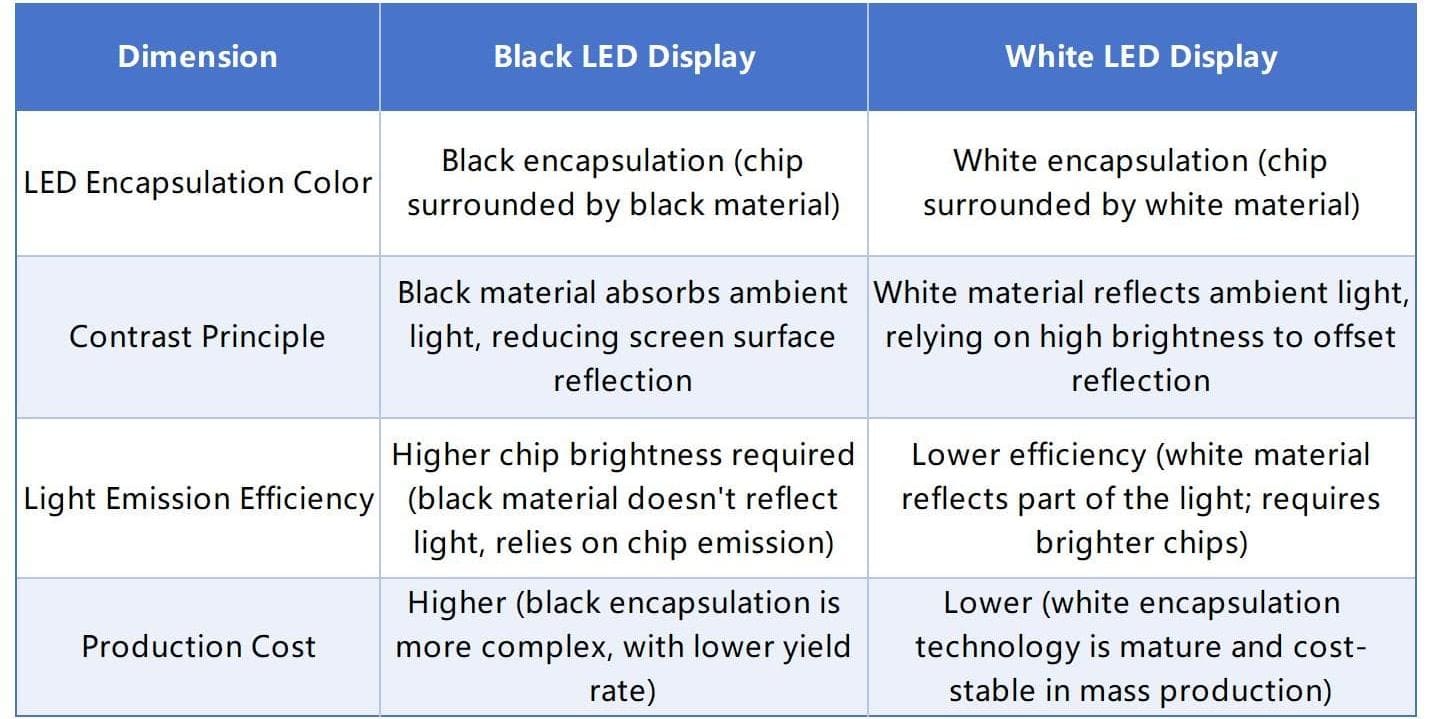The Pros & Cons And Differences Comparison Between Black And White LED Lamp Beads in LED Display Screens
Black and white LED lamp bead display screens are so named based on the color of LED beads' packaging (black or white gel), and there are obvious differences between them in display effect, technical parameters and application fields.
The LED assembly consists of a plastic bracket and a lighting wafer. Since the initial brightness of the lighting wafer is relatively low, the plastic bracket is designed in a white bowl shape by engineers to increase the focusing and reflection effects so that the lower-brightness wafer can achieve a brighter wafer effect.
Black LED lamp beads display screens are produced to meet people's demands for image fidelity. The manufacturer of LED display screen began to produce black LED lamp beads in order to enhance the contrast of LED display screens.
The optical characteristics and structure of the lamp beads

Advantages and disadvantages comparison
1. Display effect
LED display screens with black lamp beads are beneficial in the following aspects:
- Extremely high contrast: The black colloid has minimal ambient light reflection and can provide a deep black field even in bright light, with a decent sense of picture layering (contrast ratio of 5000:1 or higher), which is appropriate for dark scene presentation (e.g., night scenes and movie scenes).
- High color saturation: The black background can better highlight the colors in the picture, especially in dark indoor environments, where color rendering is more realistic.
Weaknesses of LED display screens with black lamp beads:
- Brightness limitation: Black colloid will not reflect light and relies on direct light from the chip. It is less bright under the same power than white light (its normal maximum brightness is about 3000-5000cd/m²), and it may require higher power consumption under intense outdoor conditions.
Advantages of LED display screens with white lamp beads:
- High brightness: White colloid reflects light and is brighter with the same chip power (the brightest can reach 6000-8000cd/m²), suitable for harsh outdoor environments (e.g., squares and transportation hubs that are directly exposed to sunlight).
- Wide viewing angle: White colloid diffusely reflects light, and there is less brightness attenuation when viewed from the side, so it can be applied to the scenario where a wide viewing angle is required (such as large exhibitions and sports events).
Disadvantages of LED display screens with white lamp beads:
- Low contrast: White colloid can easily reflect ambient light. In nighttime or indoor scenes, black images will be "grayish", and contrast is likely to be 2000:1 to 3000:1.
- Pale colors: Colors are prone to overexposure when there is high brightness, with significant loss of details in the dark parts. It is sufficient for displaying bright and vivid content (e.g., advertising slogans and dynamic text and graphics).
2. Environmental adaptability
Black lamp beads: More suitable for indoor, semi-outdoor (e.g., window displays, atriums of shopping malls) or night scenes, and with high requirements on ambient light control (e.g., studios, high-level exhibition halls).
White lamp beads: More suitable for full-outdoor strong light scenes (e.g., outdoor advertising screens, traffic guidance screens), or public areas that require wide viewing angles and high brightness.
3. Power consumption and heat dissipation
Black lamp beads: It requires more chip power to achieve the same brightness, with slightly more power consumption and more stringent heat dissipation design conditions (especially for the scenario of high-temperature outdoor application).
White lamp beads: It's brighter through the colloid reflection. Under the same brightness, it has less power consumption and less heat dissipation pressure, which can be applied to long-time high-load working.
4. Cost and maintenance
Black lamp beads: High cost, complex black colloid process (such as nano-coating technology), low yield of lamp beads, and overall cost 15%-30% higher than white lamp beads.
Difficult maintenance: In high pixel density (such as small-pitch screen), the black gel will become dirty, and cleaning requires more precise operations.
White lamp beads: Low cost, mature technology, stable mass production price, suitable for large-scale commercial projects.
Easy maintenance: The smooth white colloid surface and the non-pronounced adhesion of dust make daily cleaning more convenient.
How to choose between the two?
- Choose LED display with black lamp beads first: In the pursuit of high contrast, high color reproduction and controllable ambient light (such as indoor or nighttime), it is suitable for high-end display, film and television production and other applications.
- Give priority to LED display with white lamp beads: In the premise of high brightness, wide viewing angle, low cost, and high outdoor light irradiation, they are suitable for large commercial advertisements, public information display and other uses.
As technology has progressed, some manufacturers have proposed a compromise solution of "dark gray lamp beads" (gray colloid, compromising contrast and brightness), or enhanced the reflection suppression ability of black lights through coating technology. The application boundaries of the two may become even more blurred in the future.



